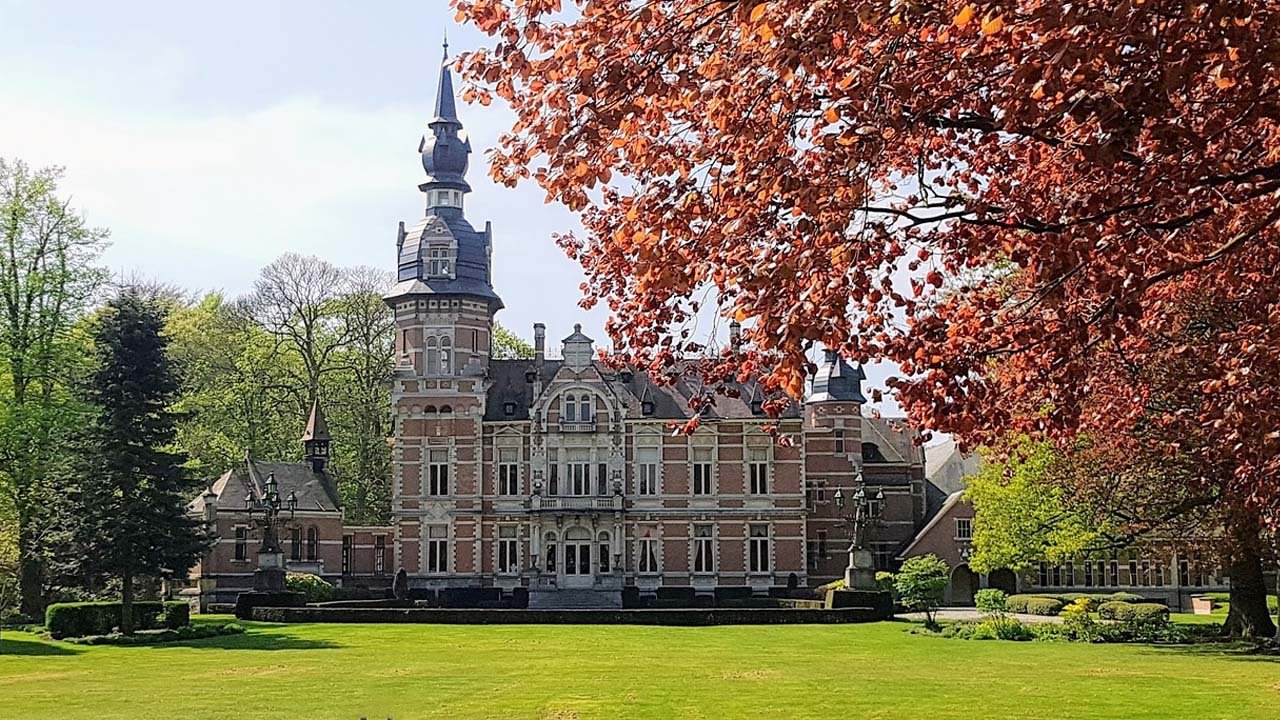14 Best Tourist Attractions in Germany: You Must Visit in 2025
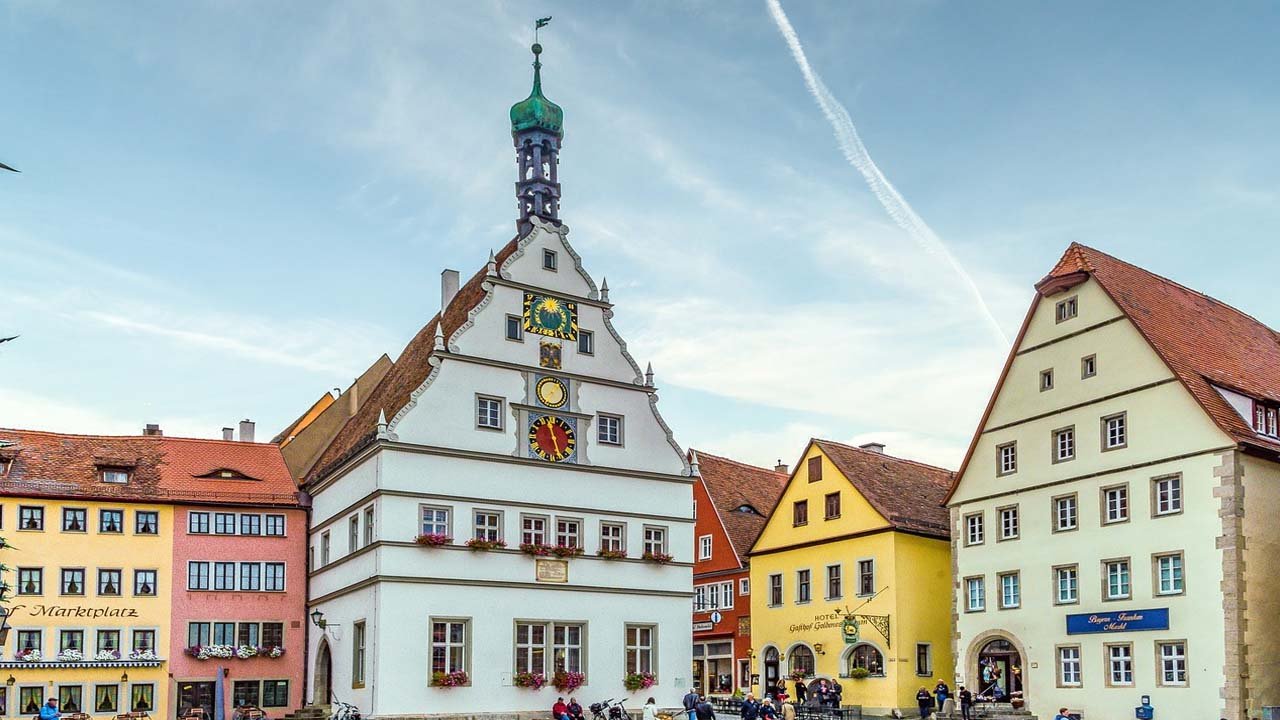
Germany is a country in Western Europe. Germany is famous for its natural beauty, great architecture and Historical background. Those things make Germany attractive to tourists from all over the world.
Today, in this blog post, I will will share 14 places in Germany that will inspire you to travel to Germany. These 14 places have historical forts as well as captivating natural beauty that will attract you.
Among These 14 places, you will find the Brandenburg Gate in Berlin, the fairy-tale Neuschwanstein Castle, and the bustling Marienplatz in Munich. Other notable sites include the breathtaking Rhine Valley and the picturesque Black Forest. Each of these locations provides an unforgettable experience.
Table of Contents
1. Brandenburg Gate, Berlin
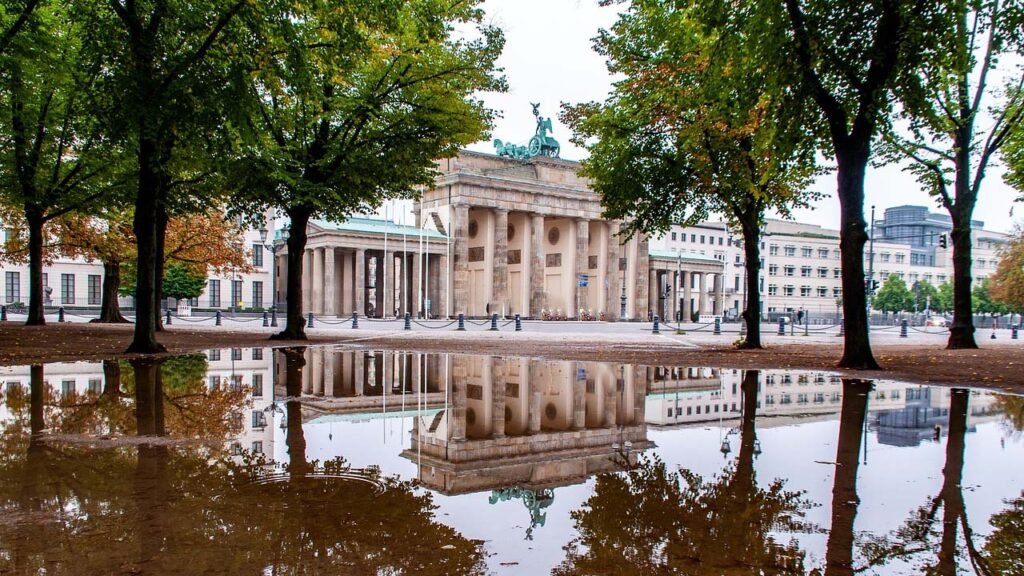
The Brandenburg Gate is one of the most famous and historic landmarks in Berlin, the capital of Germany. Constructed between 1788 and 1791 under the orders of Prussian King Friedrich Wilhelm II, the gate was designed by architect Karl Gotthard Langhans, who drew inspiration from ancient Greek architecture. At the top of the gate sits the goddess of victory (Quadriga) on a chariot drawn by four horses, which adds to the monument’s appeal.
The gate is renowned not only for its architectural beauty but also for its significant role in German history. It suffered extensive damage during World War II and, during the Cold War, became a symbol of the division between East and West Berlin. The Berlin Wall was built nearby, making the gate a silent witness to a segregated Germany. However, after the fall of the Berlin Wall in 1989, the Brandenburg Gate transformed into a symbol of German unity and freedom.
Today, it is open to tourists and serves as one of Berlin’s main attractions. Located in the heart of the city, the gate is surrounded by many other important sites, including the Reichstag building, Tiergarten park, and the Holocaust Memorial.
2. Neuschwanstein Castle, Bavaria
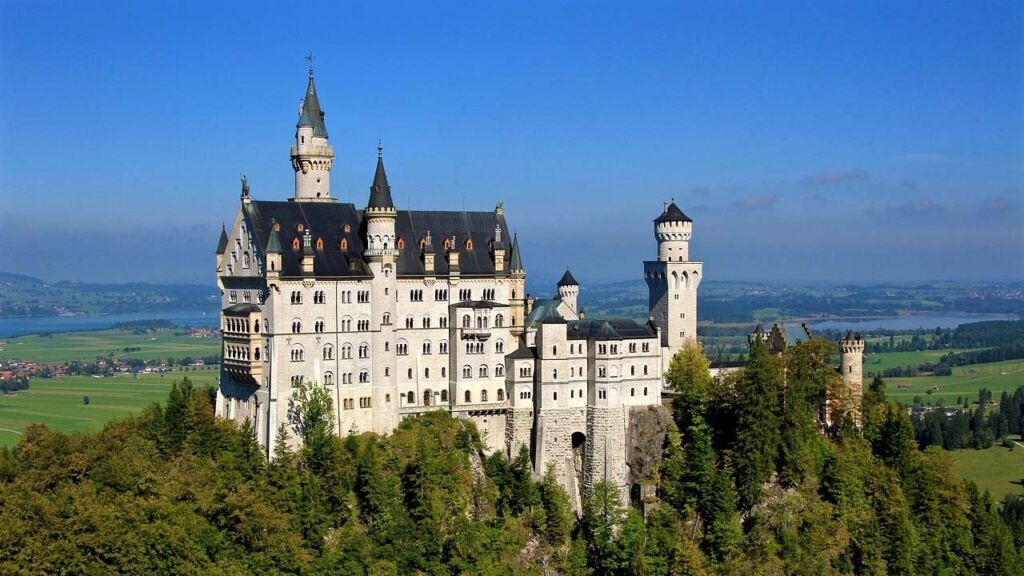
Neuschwanstein Castle is a dreamlike palace located in Bavaria, Germany, and is known as one of the most popular and picturesque castles in the world. Located at the foot of the Alps, near the small town of Füssen, the castle was built by King Ludwig II of Bavaria. Construction began in 1869, and although it was never fully completed, its majestic design and fairy-tale beauty still fascinate visitors today.
This castle is very popular not only with German tourists, but also with visitors from all over the world. More than 1.5 million people visit this castle every year. It is also known as the inspiration for Disney’s “Cinderella Castle”, which makes it even more famous. The beautiful mountains, green forests and lakes surrounding the castle create a wonderful natural environment, which is ideal for photographers and nature lovers.
If you want to visit Neuschwanstein Castle, you can easily reach it by bus or train from the city of Füssen. Since it is located on a hill, you have to walk a bit, but you can also reach it by horse-drawn carriage. The beauty of this castle is different in both seasons – summer and winter, but seeing the snow-covered castle in winter is truly like entering a fairy tale!
3. Cologne Cathedral, Cologne
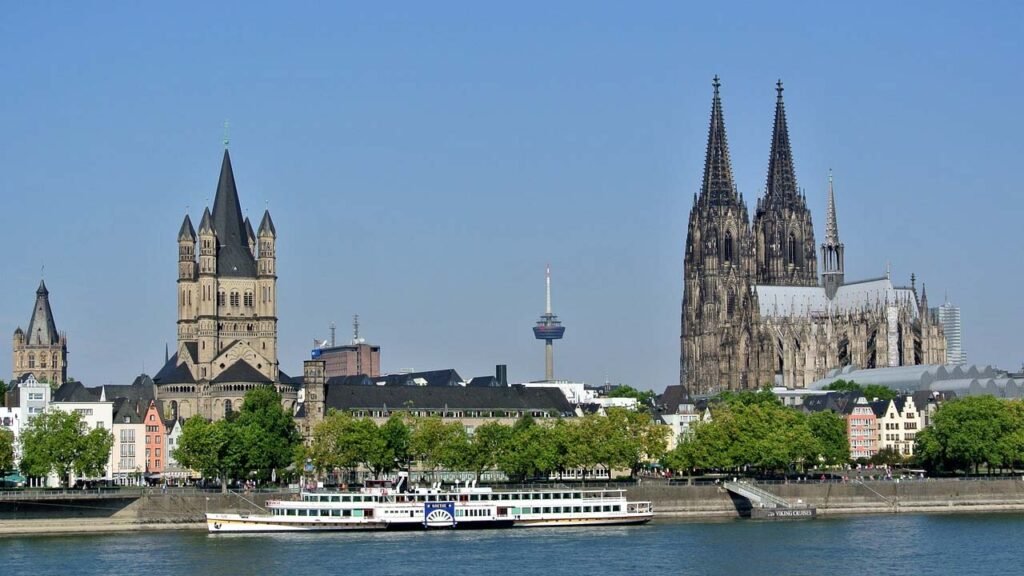
Cologne Cathedral is a world-famous Gothic architectural masterpiece and Catholic church located in Germany. It is the most recognizable symbol of the city of Cologne and one of the largest churches in Europe. Its construction began in 1248, and after a long break, it was finally completed in 1880. The construction period of almost 600 years makes it an important chapter in architectural history. The church is a UNESCO World Heritage Site, and millions of tourists and religious people visit it every year.
Cologne Cathedral stands at 157 meters, making it the tallest church in Germany and one of the tallest in the world. Its two towering towers create a striking feature on the Cologne skyline. The interior of the church features ornate windows, ancient religious paintings, a large organ, and medieval religious artifacts that take visitors deep into history. The church’s most prized possession is the “Relics of the Three Kings” – believed to be the remains of the Three Wise Men, and they are kept in an ornate gold coffin.
The chance to climb the church’s top tower is one of the main attractions for tourists. After climbing about 500 spiral stairs, the view of the entire city of Cologne and the Rhine River opens up before your eyes, which is undoubtedly an unforgettable experience. There are many historical museums, cafes, and walkways along the Rhine River around the church – which makes the trip even more enjoyable.
4. The Black Forest, Baden-Württemberg
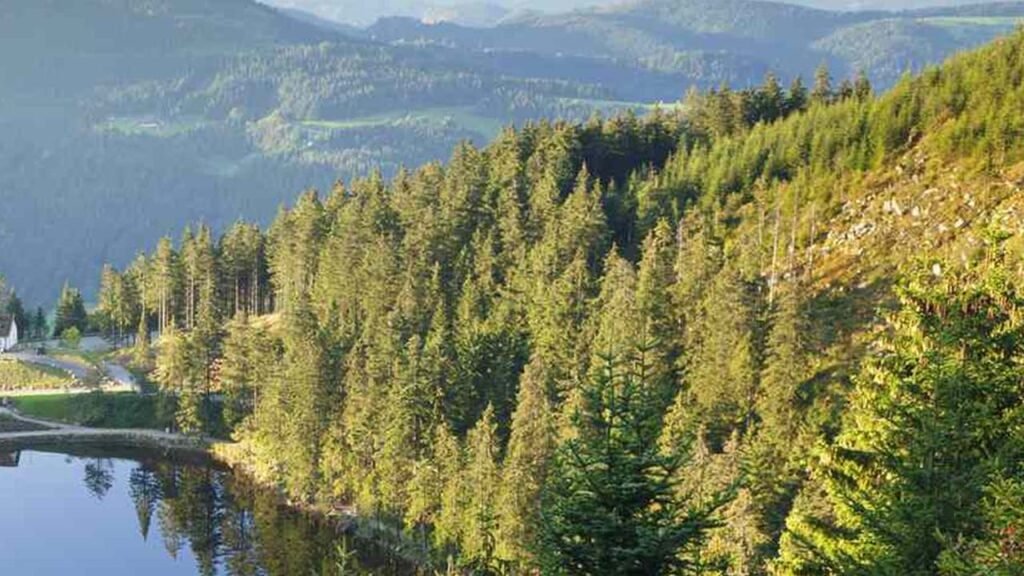
The Black Forest is a vast mountain forest located in the southwestern part of Germany, in the state of Baden-Württemberg, which is world-famous for its natural beauty, fairy-tale atmosphere, and traditional culture. Known in German as “Schwarzwald,” the forest, with its unique combination of lush greenery, clear lakes, mountain paths, and traditional villages, creates a dreamlike atmosphere that is very popular with tourists.
The Black Forest region is about 160 kilometers long and 50 kilometers wide. It is not just a forest, but also contains many mountain towns, spa towns, and hiking and cycling trails. Among the most famous cities here is Baden-Baden, known for its hot springs and luxurious spa resorts. There is also Freiburg, an ancient university city and the main gateway to the Black Forest.
The natural beauty of the Black Forest is a great attraction for tourists. Here you can visit beautiful lakes such as Lake Titisee and Schluchsee, waterfalls such as the Triberg Waterfalls – known as the highest waterfall in Germany. While there are opportunities for trekking, bike riding and canoeing in spring and summer, the region becomes a paradise for ski and snow sports lovers in winter.
The best time to visit the Black Forest is spring and autumn, when the weather is pleasant and the nature is colorful. Tourists can easily travel from one end of the region to the other by car, train or bicycle. For those who like to enjoy nature, culture and history together – the Black Forest is a unique destination.
5. The Berlin Wall Memorial, Berlin
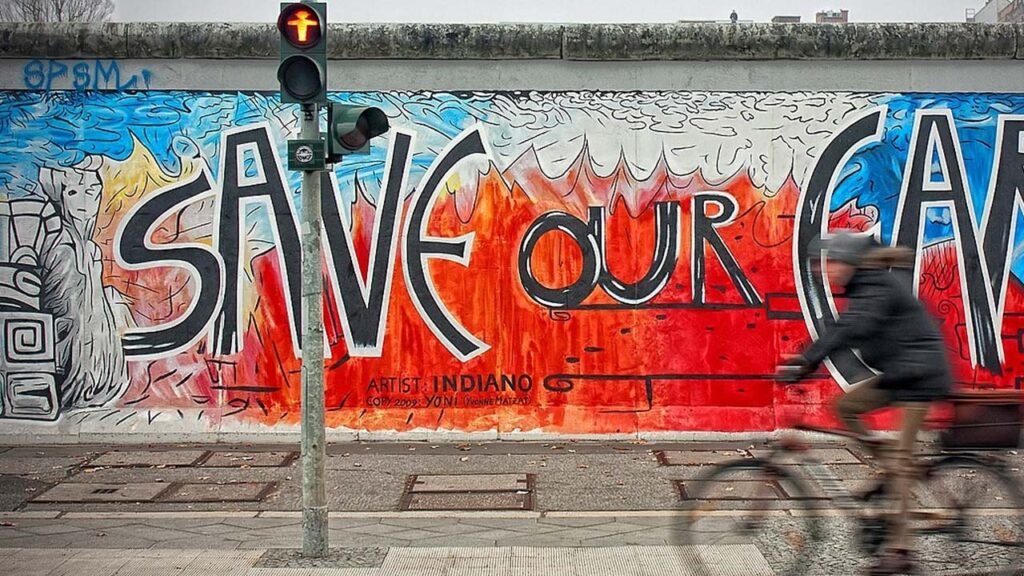
The Berlin Wall Memorial is an important and moving landmark located in Berlin, Germany. It symbolizes the political division that defined the 20th century and the Cold War. The Berlin Wall, which was erected in 1961, separated East and West Berlin for nearly three decades.The wall was not just a concrete barrier, but also bore witness to the stories of thousands of people, the pain of broken families, and the struggle for liberation. Today, this memorial, located on Bernauer Strasse, was built to commemorate that history.
The Berlin Wall Memorial is a free museum and memorial area that extends for about 1.4 kilometers. It contains a preserved section of the original wall, a watchtower, a reconstruction of the “Death Strip”, and an information center, which helps visitors understand the reality of that time. The site has been preserved in such a way that tourists can understand how the wall was built and how it divided the city and people’s lives in two.
The information center features photo galleries, video archives, and interviews that tell the stories of East and West Berliners. There are also exhibitions and guided tours available in multiple languages. Visitors can also explore the site on their own, as the entire memorial area is freely accessible and each section is marked with information boards and signs. This is a must-see for anyone interested in learning about Germany’s political history, or for those who want to delve deeper into the history of the city of Berlin.
6. Heidelberg Castle, Heidelberg
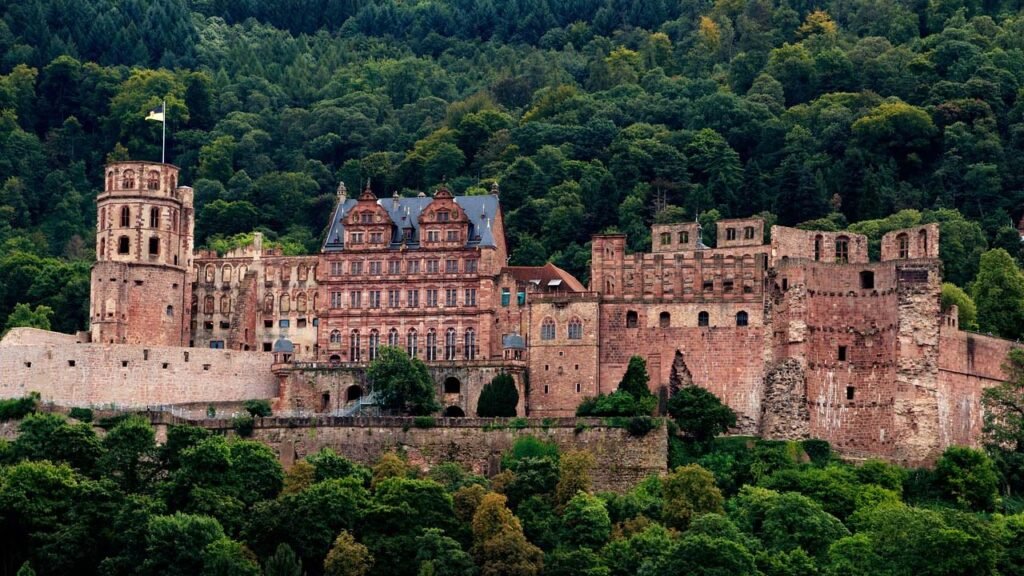
Heidelberg Castle is one of Germany’s most historic and spectacular buildings, located on a hilltop in the southwestern city of Heidelberg. It is a unique example of Renaissance architecture and a wonderful blend of German history, culture, and romanticism. Although construction began in the 13th century, it is now partially destroyed due to wars, fires, and destruction, but its beauty and importance have not diminished.
Heidelberg Castle was used as the royal palace of the rulers of the Palatinate region for a long time. Its architectural style clearly shows the signs of the Gothic and Renaissance eras. The artwork carved on the walls of the palace, the vast courtyard, and the ruins of historical buildings tell a story of history. The world’s largest wine cask (Great Heidelberg Tun) and the German Pharmacy Museum are particularly attractive to tourists.
The castle overlooks the city of Heidelberg and the Neckar River valley, which is a very charming view. Tourists are not only satisfied with visiting the castle, but also walk along the nearby Philosopher’s Walk, a mountain path from which panoramic views of the castle and the city can be enjoyed.
Heidelberg Castle is not only a must-see for history buffs, but also for any traveler who wants to enjoy nature, architecture and a peaceful environment. To reach Kassel, there is the convenience of using the funicular railway (Heidelberg Bergbahn) from the city center, which is a short adventure in itself.
The city of Heidelberg and the castle together create a unique romantic experience, which is considered a must-see on Germany’s historical itinerary. If you have time, you can also enjoy guided tours of the castle grounds, historical theater performances or seasonal festivals.
7. Zugspitze Mountain, Bavaria
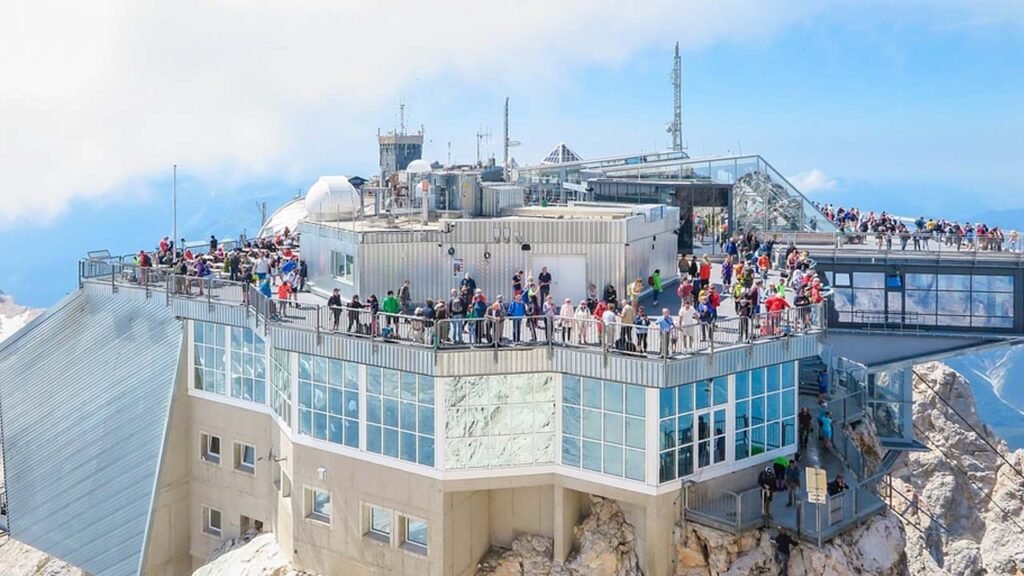
Zugspitze is the highest mountain in Germany, located in the state of Bavaria and close to the Austrian border. The mountain is about 2,962 meters (9,717 ft), making it the highest peak in the Alpine region and in Germany as a whole. Zugspitze is not just a mountain, but a complete tourist destination, where nature, adventure, ski sports and beautiful views come together to create a unique experience.
The Zugspitze Cable Car and the Zugspitzbahn are modern cable cars that provide easy and comfortable travel for tourists. After reaching the summit, a panoramic view of more than 400 Alpine peaks opens up before the eyes, which on clear days can be seen as far as Germany, Austria, Switzerland and parts of Italy.
In winter, Zugspitze becomes a popular ski resort. The Zugspitzplatt Glacier area here has snow-covered ski slopes, which are suitable for both novice and experienced skiers. There are also opportunities for snowboarding, snowshoeing and ice climbing. In the summer, the area offers numerous trails for hiking, trekking and rock climbing, which make for a wonderful experience for nature lovers.
There is a restaurant, a visitor centre and an information centre at the top of the mountain, from where you can learn about the history and nature of the mountain. The town of Garmisch-Partenkirchen, located around the Zugspitze, is one of the highlights of this trip, where traditional Bavarian culture, local cuisine and a pleasant atmosphere attract tourists.
A trip to the Zugspitze is considered a highlight of any trip to Germany, as it offers a wonderful combination of natural splendour, modern tourist facilities and adventure. The Zugspitze is undoubtedly a must-see for those who want to enjoy the unique beauty of the German Alps.
8. Miniatur Wunderland, Hamburg
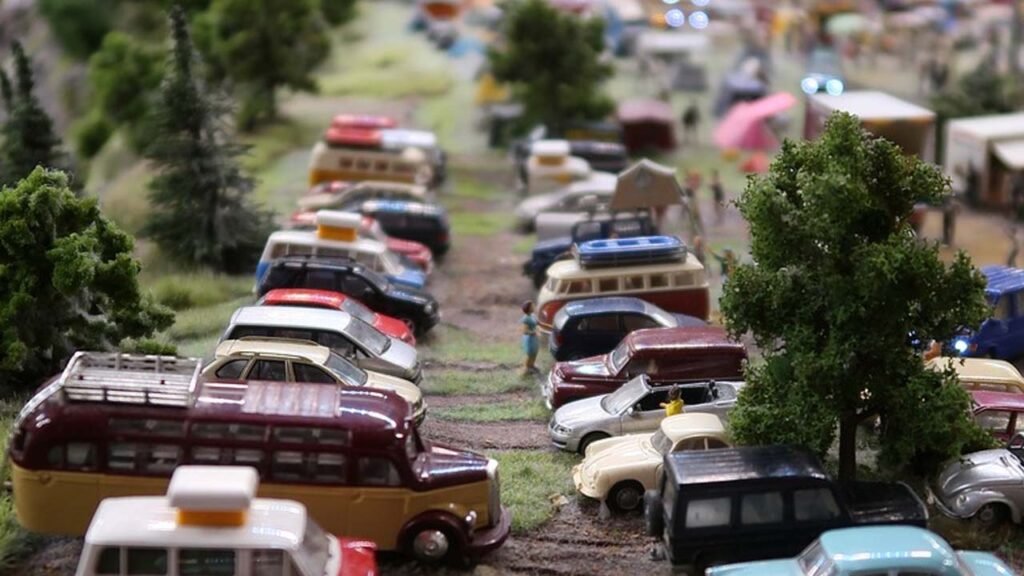
Miniatur Wunderland is the world’s largest model railway and mini-world exhibition located in Hamburg, Germany, and is a great destination for families, children, technology enthusiasts, and general tourists. It is located in the historic warehouse district of Speicherstadt and has been one of the most popular indoor attractions in Europe since it opened in 2001.
Miniatur Wunderland is a vast area of miniature replicas of various countries. Here, famous cities, landscapes, railway stations, ports, mountains, and airports from Germany, Switzerland, Italy, America, Norway, Sweden, Finland, South America, and many other countries are recreated in extremely accurate models. The most amazing thing is that these models include moving trains, cars, and even a functioning mini-airport (Knuffingen Airport), where planes take off and land completely automatically.
This exhibition is not just a static exhibition – every part has animation, light, sound, and moving systems that bring the models to life. The changing light between day and night, the traffic signals, the moving waterfalls, the movements of people and animals are all created with great precision. It is essentially a technological marvel and a work of art that fascinates both children and adults.
Miniatur Wunderland attracts more than a million visitors every year and is expanding day by day. It takes about a few hours to see it, because each of its areas hides countless detailed and interesting little scenes – for example: a wedding ceremony in one place, a car accident or a music concert in another – all on a miniature scale.
For tourists, there is an information center, a restaurant, guided tours and special facilities for families. Miniatur Wunderland is a must-see when visiting the city of Hamburg, because it offers a unique experience of knowledge, entertainment and wonder.
9. Marienplatz and New Town Hall, Munich
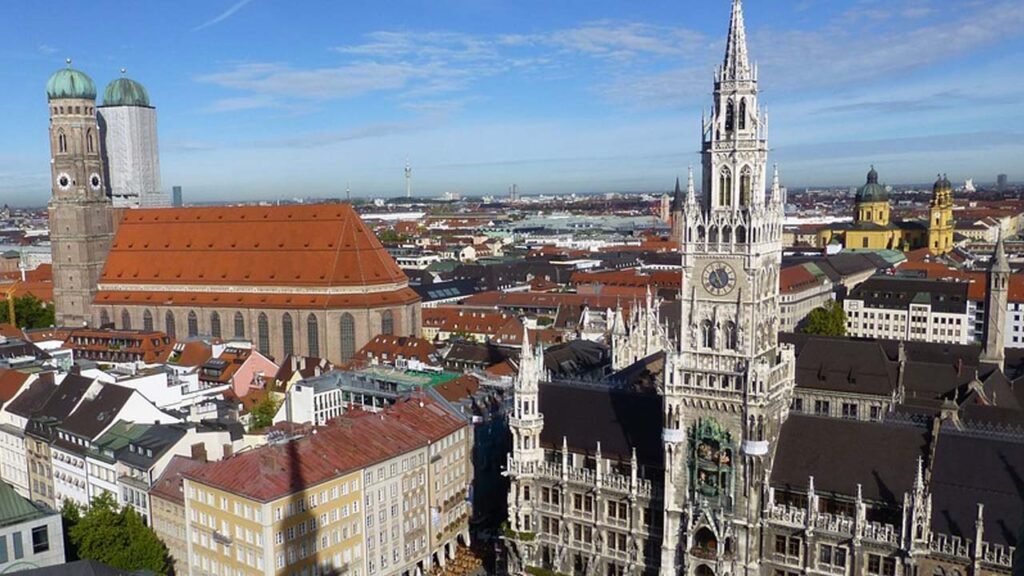
The most important attraction of Marienplatz is the New Town Hall (New Town Hall or Neues Rathaus), a large Gothic Revival building built between 1867 and 1908. Its magnificent decoration, high towers, and over 100-meter-long facade make it an architectural masterpiece. The most striking feature of the building is its huge clock and Glockenspiel, which are set in motion every day at fixed times (usually 11:00 a.m., 12:00 p.m., and 5:00 p.m. in summer) and feature 43 bells and 32 moving puppets depicting scenes from German history.
It is possible to climb the tower of the New Town Hall, from which you can enjoy a panoramic view of the entire city of Munich. On a clear day, the Alps can be seen in the distance. In addition to the administrative offices of the city of Munich, this building also houses the tourist information center, and is surrounded by numerous shops, cafes, and traditional Bavarian restaurants.
Marienplatz is known as the main venue for the city’s festivals and cultural events. Especially during Christmas, the famous Christmas Market is held here, which is an incomparable experience for tourists. In addition, Munich’s traditional festivals, concerts and public gatherings are held from here.
For those who want to experience the history, architecture and cultural atmosphere of Munich together, Marienplatz and the New Town Hall are definitely worth visiting. It is not just a tourist attraction, but a living part of the soul and history of Munich.
10. Sanssouci Palace, Potsdam
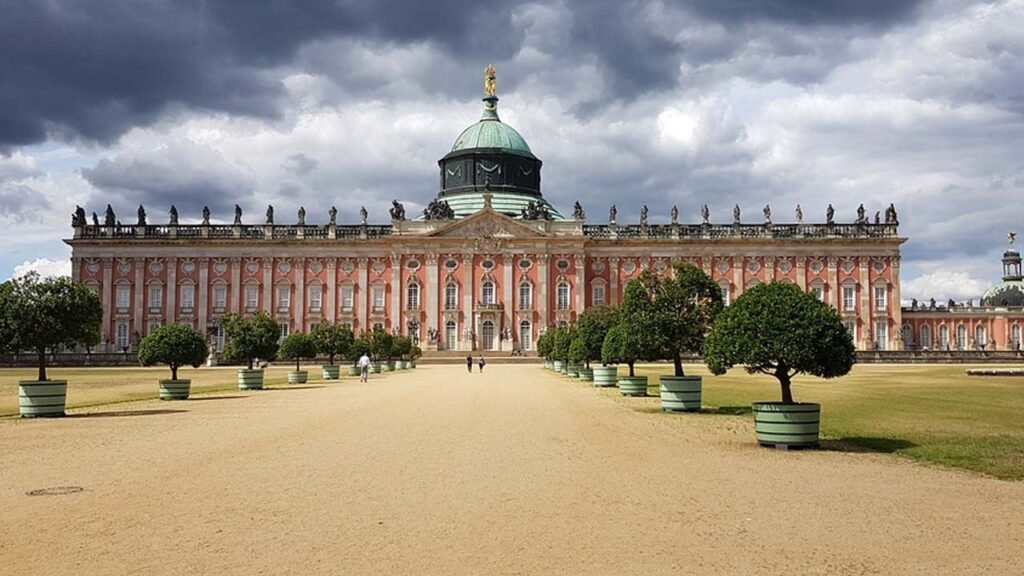
Sanssouci Palace is a famous palace in Potsdam, Germany, built as the summer residence of the Prussian King Frederick the Great. “Sans souci” is a French word meaning “carefree” or “free from worries”. As the name suggests, the king built the palace to relax and enjoy creativity while free from royal duties. It is a unique example of German Rococo architecture and a UNESCO World Heritage Site.
Sanssouci Palace was built between 1745 and 1747, and was designed by architect Georg Wenzeslaus von Knobelsdorff, under Frederick’s direct supervision. Although the palace is relatively small and has one floor, its interior decoration, paintings, marble floors, and gilded ceilings are truly eye-catching. Inside are the royal residences, dining halls, libraries, and guest rooms — each room is filled with historic art and decoration.
One of the main attractions of this palace is the vast Baroque garden surrounding it. There are six tiers of terraced vineyards, marble statues, fountains, and manicured walkways. Walking through this garden, you will come across other smaller palaces and buildings — such as the New Palace, Chinese House, and Orangery Palace, which also attract tourists in their own right.
Sanssouci Palace is not only famous for its architecture and history, but also for the philosophical and cultural contributions of Frederick the Great. He was a thinker and music-loving king, whose residence in this palace reflects his philosophy of life. He is buried near the palace, according to his wishes — on a simple tombstone, next to his beloved dogs.
Sanssouci Palace attracts millions of tourists each year and is considered the main attraction of the city of Potsdam. It is easily accessible by train from Berlin, and it is possible to visit the palace and the surrounding gardens in a day. For those who enjoy the wonderful combination of history, architecture and nature — Sanssouci is undoubtedly a unique destination.
11. Rhine Valley, Rhineland
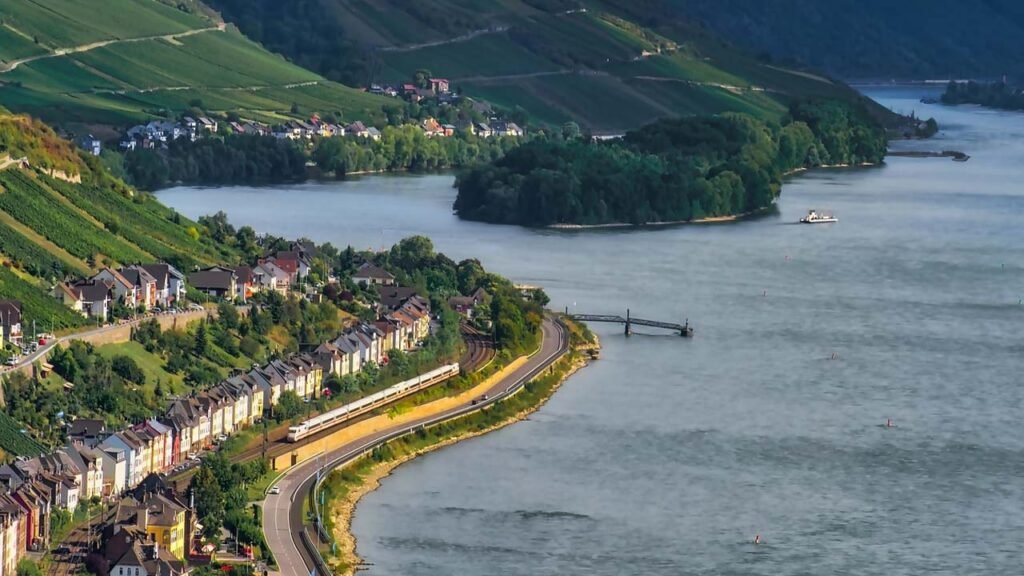
The Rhine Valley is one of the most beautiful and historic natural regions in Germany, stretching through the states of Rhineland-Palatinate and Hesse. The valley is mainly formed by the Rhine River, a major river in Central Europe and an important part of German culture, history and geography. The Rhine Valley is very popular with tourists for its natural beauty, historic castles, vineyards and small towns that look like fairy tales.
This region is especially known as the Upper Middle Rhine Valley, which is recognized as a UNESCO World Heritage Site. Here, on both banks of the river, there are rows of medieval castles and palaces — such as Marksburg Castle, Rheinfels Castle and Pfalzgrafenstein Castle, which were once used to collect taxes on the Rhine and defend it. Each castle carries a different historical story, and many castles are open to visitors.
The cities of the Rhine Valley are also very attractive for tourism. From the city of Koblenz to Bacharach, Rüdesheim and St. Goar – each town has old German architecture, shops lined up in narrow streets, opportunities for local wine tasting, and riverside cafes and restaurants. The vineyards here produce the famous Riesling wine, which is the pride of Germany.
Boat trips are the most popular way to explore the Rhine Valley. A river cruise through the picturesque sights is a wonderful experience. The trip becomes even more colorful in spring and summer, as the river banks are in bloom, the vineyards are green, and festivals and concerts are held in various villages.
12. Frankfurt’s Römerberg, Frankfurt
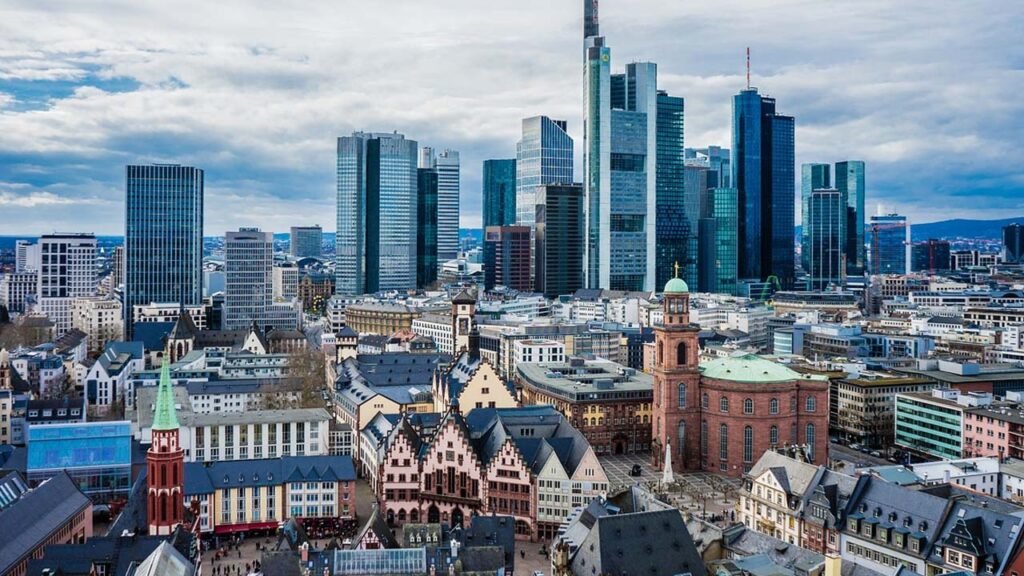
The Römerberg is the historic heart of Frankfurt, Germany, or the “Old Town Square”, and is a symbol of the city’s cultural and historical heritage. The name “Römerberg” (Roman Hill) comes from the medieval administrative building “Römer”, which has served as the city’s town hall for 600 years. Standing on the Römerberg feels like time has stood still – rows of colorful, half-timbered houses, ancient fountains, and cobblestone streets bring medieval Germany to life.
The square was once used for coronations, markets, fairs, and public gatherings. Today, it is one of Frankfurt’s most popular tourist attractions and the main venue for various festivals, especially the Christmas Market. During this time, the square is filled with sparkling lights, wooden stalls, and the smell of mulled wine, creating a charming festive atmosphere.
One of the main attractions of the Römerberg is the “Gerechtigkeitsbrunnen” or “Fountain of Justice”, which is located in the center of the square. It is surrounded by many historic buildings, such as the Römer (town hall), the Alte Nikolaikirche (old Nicholas Church), and various museums and galleries. Many of the buildings were destroyed during World War II, but were later rebuilt in their original form, which is a shining example of the city’s heritage preservation.
13. Dresden Frauenkirche, Dresden
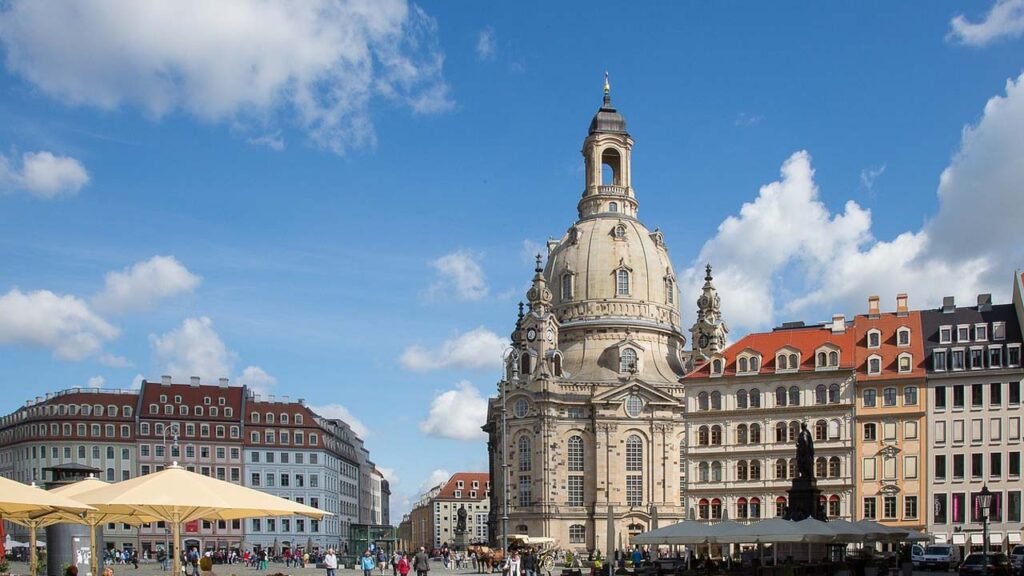
The Dresden Frauenkirche, or “Church of Our Lady”, is a historic and symbolic church in Dresden, the capital of the German state of Saxony. It is one of the most beautiful examples of Baroque architecture in Europe and a stunning example of reconstruction after the devastation of World War II. Originally built in the 18th century, the church was completely destroyed by Allied bombing in 1945, and remained a ruin for a long time.
After German reunification, reconstruction work began in 1994 with public enthusiasm, donations, and international support, and the church was reopened to the public in 2005. The reconstruction used as much of the original stone and design as possible, and the black paint from the destroyed parts is still visible on the church — creating a unique blend of past and present.
The Frauenkirche’s architecture and interior are extraordinary. Its massive domed roof, marble-like interior walls, and exquisite decoration captivate visitors. Inside is a large organ, a main altar, and a round decorated balcony, which can accommodate thousands of visitors at a time. It is not only a place of religious worship, but also used for concerts and cultural events.
Today, the church is a symbol of peace, reunification, and victory over history in Germany. In the vicinity of the Frauenkirche, there are many other attractions in Dresden — such as the Zwinger Palace, the Semper Opera House, and Brühl’s Terrace, which make the entire city a wonderful cultural center.
14. Museum Island, Berlin
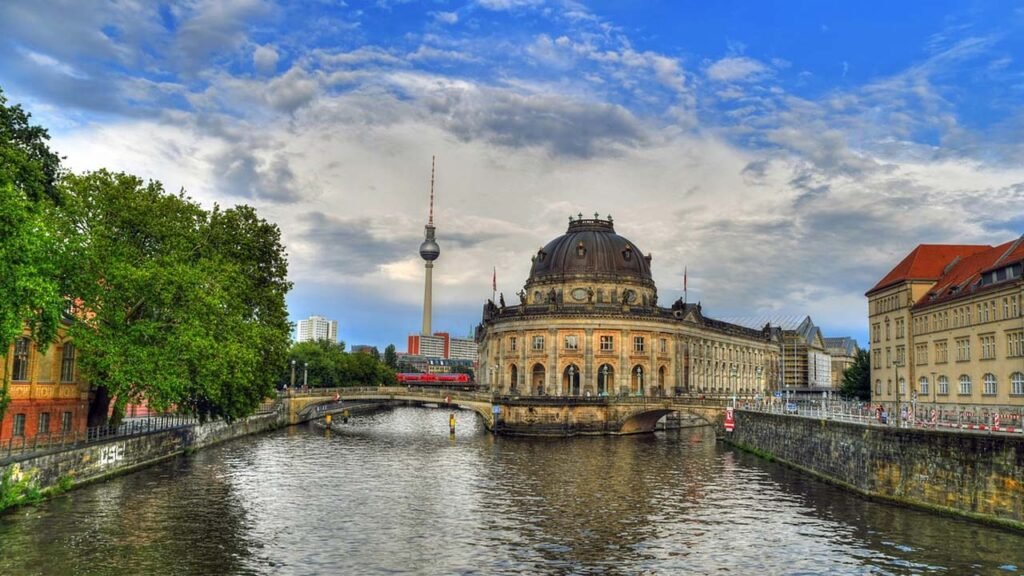
Museum Island is located on an island in the middle of the Spree River in the German capital of Berlin, which is recognized as one of the most important cultural and historical sites in the world. It is a UNESCO World Heritage Site, where five famous museums are located together. Museum Island is not only a tourist destination, but also a repository of priceless treasures of history, art and human civilization spanning thousands of years.
The five main museums on this island are: Altes Museum, Neues Museum, Alte Nationalgalerie, Bode Museum, and Pergamon Museum. Each museum has a unique architectural style and exhibitions, which bring history and culture to life. Visitors come here not only to visit the museums, but also to spend time in the natural environment of the island, sitting by the river, or visiting the nearby Berliner Dom (Berlin Cathedral).
Separate tickets or combo passes are available for entry to Museum Island, which allows you to visit multiple museums in one day. It is located in the Mitte district of Berlin and is easily accessible by any public transport.
Germany is not just a country of technology and modern cities — it is also a treasure trove of history, nature and culture. From Berlin’s monumental Museum Island to Frankfurt’s Römerberg, Dresden’s revived Frauenkirche, or Hamburg’s stunning Miniatur Wunderland — each place has a story to tell about Germany’s glorious past and modern transformation.
On the other hand, Neuschwanstein Castle or Sanssouci Palace will make you feel like you’ve entered a fairy tale. Places full of Natural locations are abundant in…natural beauty, such as the Rhine Valley and Zugspitze, provide both serenity and excitement.ural beauty like the Rhine Valley and Zugspitze offer both tranquility and adventure. And Marienplatz, Heidelberg Castle and the Black Forest – all together, Germany becomes a complete travel experience.
If you are looking for a diverse destination with a mix of history, nature, architecture and culture, then Germany should undoubtedly be at the top of your travel list.


